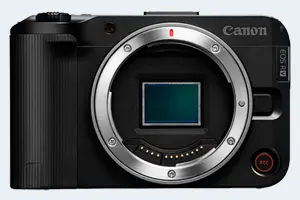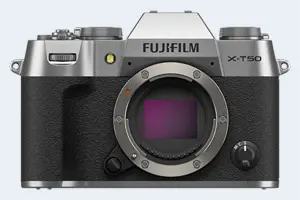Canon R50 V vs Fujifilm X-T50
The Canon EOS R50 V and the Fujifilm X-T50 are two digital cameras that were revealed to the public, respectively, in March 2025 and May 2024. Both the R50 V and the X-T50 are mirrorless interchangeable lens cameras that are equipped with an APS-C sensor. The Canon has a resolution of 24 megapixels, whereas the Fujifilm provides 39.8 MP.
Below is an overview of the main specs of the two cameras as a starting point for the comparison.

Check R50 V price at
amazon.com

Check X-T50 price at
amazon.com
Going beyond this snapshot of core features and characteristics, what are the differences between the Canon EOS R50 V and the Fujifilm X-T50? Which one should you buy? Read on to find out how these two cameras compare with respect to their body size, their imaging sensors, their shooting features, their input-output connections, and their reception by expert reviewers.
Body comparison
An illustration of the physical size and weight of the Canon R50 V and the Fujifilm X-T50 is provided in the side-by-side display below. The two cameras are presented according to their relative size. Three successive views from the front, the top, and the rear are shown. All width, height and depth measures are rounded to the nearest millimeter.
The X-T50 can be obtained in two different colors (black, silver), while the R50 V is only available in black.
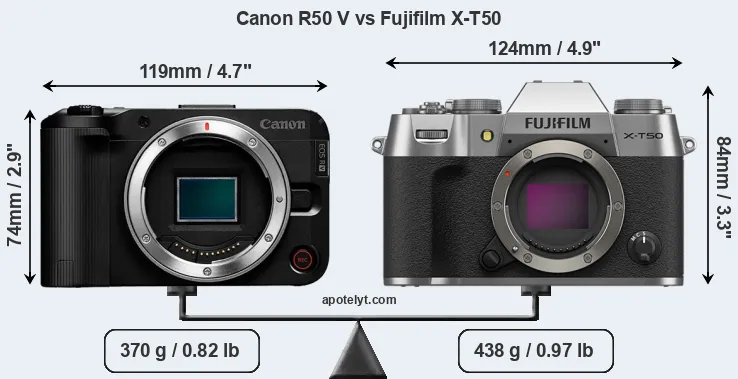

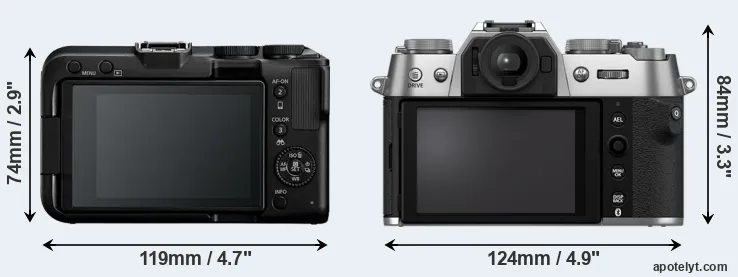
If the front view area (width x height) of the cameras is taken as an aggregate measure of their size, the Fujifilm X-T50 is notably larger (18 percent) than the Canon R50 V. Moreover, the X-T50 is markedly heavier (18 percent) than the R50 V. In this context, it is worth noting that neither the R50 V nor the X-T50 are weather-sealed.
The above size and weight comparisons are to some extent incomplete since they do not consider the interchangeable lenses that both of these cameras require. Hence, you might want to study and compare the specifications of available lenses in order to get the full picture of the size and weight of the two camera systems.
Concerning battery life, the R50 V gets 390 shots out of its Canon LP-E17 battery, while the X-T50 can take 305 images on a single charge of its Fujifilm NP-W126S power pack. The battery packs of both cameras can be charged via USB, which can be very convenient when travelling.
The following table provides a synthesis of the main physical specifications of the two cameras and other similar ones. If you want to switch the focus of the display and review another camera pair, you can move across to the CAM-parator tool and choose from the broad selection of possible camera comparisons there.

| Camera Model |
Camera Width |
Camera Height |
Camera Depth |
Camera Weight |
Battery Life |
Weather Sealing |
Camera Launch |
Launch Price |
Street Price |
||
|---|---|---|---|---|---|---|---|---|---|---|---|
| 1. | Canon R50 V | 119 mm | 74 mm | 45 mm | 370 g | 390 | n | Mar 2025 | EUR 759 | amazon.com | |
| 2. | Fujifilm X-T50 | 124 mm | 84 mm | 49 mm | 438 g | 305 | n | May 2024 | EUR 1 499 | amazon.com | |
| 3. | Canon 250D | 122 mm | 93 mm | 70 mm | 449 g | 1070 | n | Apr 2019 | EUR 549 | amazon.com | |
| 4. | Canon G7 X Mark II | 106 mm | 61 mm | 42 mm | 319 g | 265 | n | Feb 2016 | EUR 685 | ebay.com | |
| 5. | Canon G7 X Mark III | 105 mm | 61 mm | 41 mm | 304 g | 235 | n | Jul 2019 | EUR 779 | amazon.com | |
| 6. | Canon M3 | 111 mm | 68 mm | 44 mm | 366 g | 250 | n | Feb 2015 | EUR 749 | ebay.com | |
| 7. | Canon M6 | 112 mm | 68 mm | 45 mm | 390 g | 295 | n | Feb 2017 | EUR 799 | ebay.com | |
| 8. | Canon M50 | 116 mm | 88 mm | 59 mm | 390 g | 235 | n | Feb 2018 | EUR 779 | ebay.com | |
| 9. | Canon M50 Mark II | 116 mm | 88 mm | 59 mm | 387 g | 305 | n | Oct 2020 | EUR 599 | ebay.com | |
| 10. | Canon R10 | 123 mm | 88 mm | 83 mm | 429 g | 450 | n | May 2022 | EUR 979 | amazon.com | |
| 11. | Canon R50 | 116 mm | 86 mm | 69 mm | 375 g | 230 | n | Feb 2023 | EUR 829 | amazon.com | |
| 12. | Canon R100 | 116 mm | 86 mm | 69 mm | 356 g | 400 | n | May 2023 | EUR 579 | amazon.com | |
| 13. | Fujifilm X-E5 | 125 mm | 73 mm | 39 mm | 445 g | 305 | n | Jun 2025 | EUR 1 549 | amazon.com | |
| 14. | Fujifilm X-Pro2 | 141 mm | 83 mm | 46 mm | 495 g | 350 | Y | Jan 2016 | EUR 1 799 | ebay.com | |
| 15. | Fujifilm X-S20 | 128 mm | 85 mm | 65 mm | 491 g | 750 | n | May 2023 | EUR 1 399 | amazon.com | |
| 16. | Fujifilm X-T5 | 130 mm | 91 mm | 64 mm | 557 g | 580 | Y | Nov 2022 | EUR 1 999 | amazon.com | |
| 17. | Fujifilm X100VI | 128 mm | 75 mm | 55 mm | 521 g | 450 | Y | Feb 2024 | EUR 1 799 | amazon.com | |
| Note: Measurements and pricing do not include easily detachable parts, such as add-on or interchangeable lenses or optional viewfinders. | |||||||||||
Any camera decision will naturally be influenced heavily by the price. The manufacturer’s suggested retail prices give an idea on the placement of the camera in the maker’s lineup and the broader market. The R50 V was launched at a markedly lower price (by 54 percent) than the X-T50, which puts it into a different market segment. Usually, retail prices stay at first close to the launch price, but after several months, discounts become available. Later in the product cycle and, in particular, when the replacement model is about to appear, further discounting and stock clearance sales often push the camera price considerably down. Then, after the new model is out, very good deals can frequently be found on the pre-owned market.
Sensor comparison
The size of the sensor inside a digital camera is one of the key determinants of image quality. A large sensor will generally have larger individual pixels that offer better low-light sensitivity, provide wider dynamic range, and have richer color-depth than smaller pixels in a sensor of the same technological generation. Further, a large sensor camera will give the photographer additional creative options when using shallow depth-of-field to isolate a subject from its background. On the downside, larger sensors are more costly to manufacture and tend to lead to bigger and heavier cameras and lenses.
Both cameras under consideration feature an APS-C sensor, but their sensors differ slightly in size. The sensor area in the X-T50 is 11 percent bigger. As a result of these sensor size differences, the cameras have format factors, respectively, of 1.6 (R50 V) and 1.5. Both cameras have a native aspect ratio (sensor width to sensor height) of 3:2.
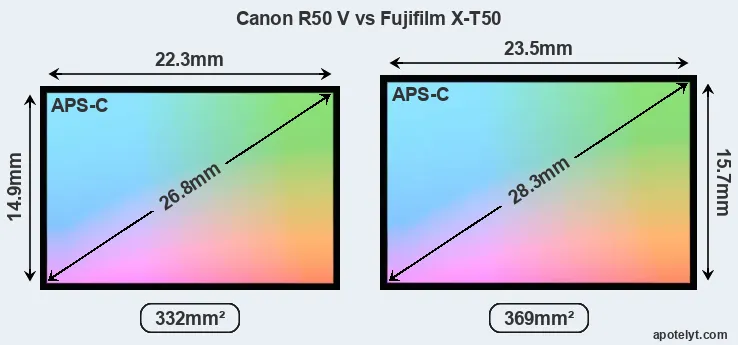
With 39.8MP, the X-T50 offers a higher resolution than the R50 V (24MP), but the X-T50 has smaller individual pixels (pixel pitch of 3.04μm versus 3.72μm for the R50 V). It is noteworthy in this context that the R50 V is a somewhat more recent model (by 10 months) than the X-T50, and its sensor might have benefitted from technological advances during this time that further enhance the light gathering capacity of its pixel-units. Coming back to sensor resolution, it should be mentioned that the X-T50 has no anti-alias filter installed, so that it can capture all the detail its sensor resolves.
The resolution advantage of the Fujifilm X-T50 implies greater flexibility for cropping images or the possibility to print larger pictures. The maximum print size of the X-T50 for good quality output (200 dots per inch) amounts to 38.6 x 25.8 inches or 98.1 x 65.4 cm, for very good quality (250 dpi) 30.9 x 20.6 inches or 78.5 x 52.3 cm, and for excellent quality (300 dpi) 25.8 x 17.2 inches or 65.4 x 43.6 cm. The corresponding values for the Canon R50 V are 30 x 20 inches or 76.2 x 50.8 cm for good quality, 24 x 16 inches or 61 x 40.6 cm for very good quality, and 20 x 13.3 inches or 50.8 x 33.9 cm for excellent quality prints.
The Canon EOS R50 V has a native sensitivity range from ISO 100 to ISO 32000, which can be extended to ISO 100-51200. The corresponding ISO settings for the Fujifilm X-T50 are ISO 125 to ISO 12800, with the possibility to increase the ISO range to 64-51200.
In terms of underlying technology, the R50 V is build around a CMOS sensor, while the X-T50 uses a BSI-CMOS imager. Like most digital cameras, the R50 V uses a Bayer filter for capturing RGB colors on a square grid of photosensors. In contrast, the X-T50 employs a more randomized X-Trans layout of photosites, which according to Fujifilm helps to minimize moiré.
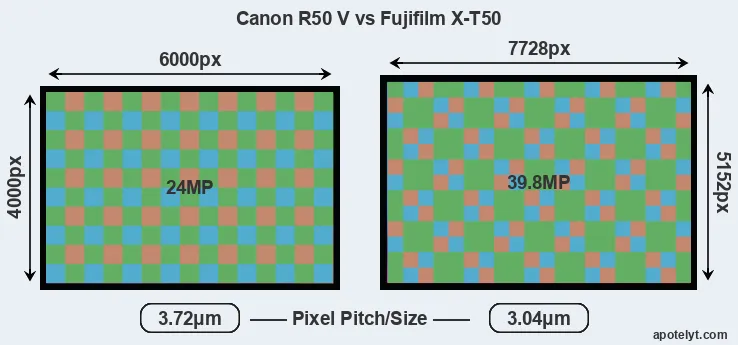
Since 2007, DXO Mark has published sensor performance measurements that have been derived using a consistent methodology. This service assesses and scores the color depth ("DXO Portrait"), dynamic range ("DXO Landscape"), and low-light sensitivity ("DXO Sports") of camera sensors, and also publishes an overall camera score. The adjacent table reports on the physical sensor characteristics and the outcomes of the DXO sensor quality tests for a sample of comparator-cameras.

| Camera Model |
Sensor Class |
Resolution (MP) |
Horiz. Pixels |
Vert. Pixels |
Video Format |
DXO Portrait |
DXO Landscape |
DXO Sports |
DXO Overall |
||
|---|---|---|---|---|---|---|---|---|---|---|---|
| 1. | Canon R50 V | APS-C | 24.0 | 6000 | 4000 | 4K/60p | 24.1 | 14.1 | 2383 | 85 | |
| 2. | Fujifilm X-T50 | APS-C | 39.8 | 7728 | 5152 | 6.2k/30p | 24.3 | 14.1 | 2418 | 86 | |
| 3. | Canon 250D | APS-C | 24.0 | 6000 | 4000 | 4K/25p | 23.9 | 13.4 | 1791 | 82 | |
| 4. | Canon G7 X Mark II | 1-inch | 20.0 | 5472 | 3648 | 1080/60p | 21.8 | 11.9 | 260 | 62 | |
| 5. | Canon G7 X Mark III | 1-inch | 20.0 | 5472 | 3648 | 4K/30p | 22.2 | 12.4 | 583 | 65 | |
| 6. | Canon M3 | APS-C | 24.0 | 6000 | 4000 | 1080/30p | 22.8 | 11.8 | 1169 | 72 | |
| 7. | Canon M6 | APS-C | 24.0 | 6000 | 4000 | 1080/60p | 23.4 | 12.6 | 1317 | 78 | |
| 8. | Canon M50 | APS-C | 24.0 | 6000 | 4000 | 4K/24p | 23.8 | 13.3 | 1684 | 81 | |
| 9. | Canon M50 Mark II | APS-C | 24.0 | 6000 | 4000 | 4K/24p | 24.0 | 13.6 | 1939 | 83 | |
| 10. | Canon R10 | APS-C | 24.0 | 6000 | 4000 | 4k/60p | 24.1 | 13.8 | 2085 | 84 | |
| 11. | Canon R50 | APS-C | 24.0 | 6000 | 4000 | 4K/30p | 24.1 | 13.9 | 2168 | 84 | |
| 12. | Canon R100 | APS-C | 24.0 | 6000 | 4000 | 4k/24p | 24.1 | 13.9 | 2197 | 84 | |
| 13. | Fujifilm X-E5 | APS-C | 39.8 | 7728 | 5152 | 6.2k/30p | 24.3 | 14.2 | 2523 | 86 | |
| 14. | Fujifilm X-Pro2 | APS-C | 24.0 | 6000 | 4000 | 1080/60p | 23.7 | 13.0 | 1608 | 80 | |
| 15. | Fujifilm X-S20 | APS-C | 26.0 | 6240 | 4160 | 4K/60p | 24.3 | 14.0 | 2315 | 86 | |
| 16. | Fujifilm X-T5 | APS-C | 39.8 | 7728 | 5152 | 6.2k/30p | 24.3 | 13.9 | 2264 | 86 | |
| 17. | Fujifilm X100VI | APS-C | 39.8 | 7728 | 5152 | 6.2K/30p | 24.3 | 14.1 | 2397 | 86 | |
| Note: DXO values in italics represent estimates based on sensor size and age. | |||||||||||
Many modern cameras are not only capable of taking still images, but can also record movies. Both cameras under consideration are equipped with sensors that have a sufficiently high read-out speed for moving images, but the X-T50 provides a better video resolution than the R50 V. It can shoot movie footage at 6.2k/30p, while the Canon is limited to 4K/60p.
Feature comparison
Beyond body and sensor, cameras can and do differ across a range of features. For example, the X-T50 has an electronic viewfinder (2360k dots), which can be very helpful when shooting in bright sunlight. In contrast, the R50 V relies on live view and the rear LCD for framing. The table below summarizes some of the other core capabilities of the Canon R50 V and Fujifilm X-T50 in connection with corresponding information for a sample of similar cameras.

| Camera Model |
Viewfinder (Type or 000 dots) |
Control Panel (yes/no) |
LCD Specifications (inch/000 dots) |
LCD Attach- ment |
Touch Screen (yes/no) |
Max Shutter Speed * |
Max Shutter Flaps * |
Built-in Flash (yes/no) |
Built-in Image Stab |
||
|---|---|---|---|---|---|---|---|---|---|---|---|
| 1. | Canon R50 V | none | n | 3.0 / 1040 | swivel | Y | 1/4000s | 12.0/s | n | n | |
| 2. | Fujifilm X-T50 | 2360 | n | 3.0 / 1840 | tilting | Y | 1/4000s | 8.0/s | Y | Y | |
| 3. | Canon 250D | optical | n | 3.0 / 1040 | swivel | Y | 1/4000s | 5.0/s | Y | n | |
| 4. | Canon G7 X Mark II | none | n | 3.0 / 1040 | tilting | Y | 1/2000s | 8.0/s | Y | Y | |
| 5. | Canon G7 X Mark III | none | n | 3.0 / 1040 | tilting | Y | 1/2000s | 30/s | Y | Y | |
| 6. | Canon M3 | optional | n | 3.0 / 1040 | tilting | Y | 1/4000s | 4.2/s | Y | n | |
| 7. | Canon M6 | optional | n | 3.0 / 1040 | tilting | Y | 1/4000s | 9.0/s | Y | n | |
| 8. | Canon M50 | 2360 | n | 3.0 / 1040 | swivel | Y | 1/4000s | 10.0/s | Y | n | |
| 9. | Canon M50 Mark II | 2360 | n | 3.0 / 1040 | swivel | Y | 1/4000s | 10.0/s | Y | n | |
| 10. | Canon R10 | 2360 | n | 3.0 / 1040 | swivel | Y | 1/8000s | 15.0/s | Y | n | |
| 11. | Canon R50 | 2360 | n | 3.0 / 1620 | swivel | Y | 1/4000s | 12.0/s | Y | n | |
| 12. | Canon R100 | 2360 | n | 3.0 / 1040 | fixed | n | 1/4000s | 6.5/s | Y | n | |
| 13. | Fujifilm X-E5 | 2360 | n | 3.0 / 1040 | tilting | Y | 1/4000s | 8.0/s | n | Y | |
| 14. | Fujifilm X-Pro2 | 2360 | n | 3.0 / 1620 | fixed | n | 1/8000s | 8.0/s | n | n | |
| 15. | Fujifilm X-S20 | 2360 | n | 3.0 / 1840 | swivel | Y | 1/4000s | 8.0/s | Y | Y | |
| 16. | Fujifilm X-T5 | 3690 | n | 3.0 / 1840 | tilting | Y | 1/8000s | 15.0/s | n | Y | |
| 17. | Fujifilm X100VI | 3690 | n | 3.0 / 1620 | tilting | Y | 1/4000s | 11.0/s | n | Y | |
| Note: *) Information refers to the mechanical shutter, unless the camera only has an electronic one. | |||||||||||
One feature that differentiates the X-T50 and the R50 V is in-body image stabilization (IBIS). The X-T50 reduces the risk of handshake-induced blur with all attached lenses, while the R50 V offers no blur reduction with lenses that themselves do not provide optical image stabilization.
The R50 V has an articulated LCD that can be turned to be front-facing. This characteristic will be appreciated by vloggers and photographers who are interested in snapping selfies. In contrast, the X-T50 does not have a selfie-screen.The reported shutter speed information refers to the use of the mechanical shutter. Yet, some cameras only have an electronic shutter, while others have an electronic shutter in addition to a mechanical one. In fact, both cameras under consideration feature an electronic shutter, which makes completely silent shooting possible. However, this mode is less suitable for photographing moving objects (risk of rolling shutter) or shooting under artificial light sources (risk of flickering).
The Canon R50 V and the Fujifilm X-T50 both have an intervalometer built-in. This enables the photographer to capture time lapse sequences, such as flower blooming, a sunset or moon rise, without purchasing an external camera trigger and related software.
Concerning the storage of imaging data, both the R50 V and the X-T50 write their files to SDXC cards.
Connectivity comparison
For some imaging applications, the extent to which a camera can communicate with its environment can be an important aspect in the camera decision process. The table below provides an overview of the connectivity of the Canon EOS R50 V and Fujifilm X-T50 and, in particular, the interfaces the cameras (and selected comparators) provide for accessory control and data transfer.

| Camera Model |
Hotshoe Port |
Internal Mic / Speaker |
Microphone Port |
Headphone Port |
HDMI Port |
USB Port |
WiFi Support |
NFC Support |
Bluetooth Support |
||
|---|---|---|---|---|---|---|---|---|---|---|---|
| 1. | Canon R50 V | Y | stereo / mono | Y | Y | micro | 3.2 | Y | - | Y | |
| 2. | Fujifilm X-T50 | Y | stereo / mono | Y | - | micro | 3.2 | Y | - | Y | |
| 3. | Canon 250D | Y | stereo / mono | Y | - | mini | 2.0 | Y | - | Y | |
| 4. | Canon G7 X Mark II | - | stereo / mono | - | - | micro | 2.0 | Y | Y | - | |
| 5. | Canon G7 X Mark III | - | stereo / mono | Y | - | micro | 3.1 | Y | - | Y | |
| 6. | Canon M3 | Y | stereo / mono | Y | - | mini | 2.0 | Y | Y | - | |
| 7. | Canon M6 | Y | stereo / mono | Y | - | mini | 2.0 | Y | Y | Y | |
| 8. | Canon M50 | Y | stereo / mono | Y | - | micro | 2.0 | Y | - | Y | |
| 9. | Canon M50 Mark II | Y | stereo / mono | Y | - | micro | 2.0 | Y | - | Y | |
| 10. | Canon R10 | Y | stereo / mono | Y | - | micro | 2.0 | Y | - | Y | |
| 11. | Canon R50 | Y | stereo / mono | Y | - | micro | 3.2 | Y | - | Y | |
| 12. | Canon R100 | Y | stereo / mono | Y | - | micro | 2.0 | Y | - | Y | |
| 13. | Fujifilm X-E5 | Y | stereo / mono | Y | - | micro | 3.2 | Y | - | Y | |
| 14. | Fujifilm X-Pro2 | Y | stereo / mono | Y | - | micro | 2.0 | Y | - | - | |
| 15. | Fujifilm X-S20 | Y | stereo / mono | Y | Y | micro | 3.2 | Y | - | Y | |
| 16. | Fujifilm X-T5 | Y | stereo / mono | Y | - | micro | 3.2 | Y | - | Y | |
| 17. | Fujifilm X100VI | Y | stereo / mono | Y | - | micro | 3.2 | Y | - | Y |
It is notable that the R50 V has a headphone jack, which is not present on the X-T50 This port makes it possible to attach external headphones and monitor the quality of sound during the recording process.
Both the R50 V and the X-T50 are recent models that are part of the current product line-up. The X-T50 replaced the earlier Fujifilm X-T30 II, while the R50 V does not have a direct predecessor. Further information on the two cameras (e.g. user guides, manuals), as well as related accessories, can be found on the official Canon and Fujifilm websites.
Review summary
So how do things add up? Is there a clear favorite between the Canon R50 V and the Fujifilm X-T50? Which camera is better? A synthesis of the relative strong points of each of the models is listed below.

Advantages of the Canon EOS R50 V:
- Better moiré control: Has an anti-alias filter to avoid artificial patterns to appear in images.
- Better sound control: Has a headphone port that enables audio monitoring while recording.
- More flexible LCD: Has a swivel screen for odd-angle shots in portrait or landscape orientation.
- More selfie-friendly: Has an articulated screen that can be turned to be front-facing.
- Faster burst: Shoots at higher frequency (12 vs 8 flaps/sec) to capture the decisive moment.
- More compact: Is smaller (119x74mm vs 124x84mm) and thus needs less room in the bag.
- Less heavy: Is lighter (by 68g or 16 percent) and hence easier to carry around.
- Longer lasting: Can take more shots (390 versus 305) on a single battery charge.
- More affordable: Was introduced into a lower priced category (54 percent cheaper at launch).
- More modern: Is somewhat more recent (announced 10 months after the X-T50).

Reasons to prefer the Fujifilm X-T50:
- More detail: Has more megapixels (39.8 vs 24MP), which boosts linear resolution by 29%.
- Maximized detail: Lacks an anti-alias filter to exploit the sensor's full resolution potential.
- Better video: Provides higher definition movie capture (6.2k/30p vs 4K/60p).
- Easier framing: Has an electronic viewfinder for image composition and settings control.
- More detailed LCD: Has a higher resolution rear screen (1840k vs 1040k dots).
- Sharper images: Has stabilization technology built-in to reduce the impact of hand-shake.
- Easier fill-in: Has a small integrated flash to brighten shadows of backlit subjects.
- More heavily discounted: Has been on the market for longer (launched in May 2024).
If the count of relative strengths (bullet points above) is taken as a measure, the R50 V emerges as the winner of the contest (10 : 8 points). However, the relative importance of the various individual camera aspects will vary according to personal preferences and needs, so that you might like to apply corresponding weights to the particular features before making a decision on a new camera. A professional wildlife photographer will view the differences between cameras in a way that diverges from the perspective of a family photog, and a person interested in architecture has distinct needs from a sports shooter. Hence, the decision which camera is best and worth buying is often a very personal one.
How about other alternatives? Do the specifications of the Canon R50 V and the Fujifilm X-T50 place the cameras among the top in their class? Find out in the latest Best Mirrorless Interchangeable Lens Camera listing whether the two cameras rank among the cream of the crop.
In any case, while the comparison of technical specifications can provide a useful overview of the capabilities of different cameras, it says little about, for example, the shooting experience and imaging performance of the R50 V and the X-T50 in practical situations. User reviews, such as those found at amazon, can sometimes inform about these issues, but such feedback is often incomplete, inconsistent, and biased.
Expert reviews
This is where reviews by experts come in. The following table reports the overall ratings of the cameras as published by some of the major camera review sites (amateurphotographer [AP], cameralabs [CL], digitalcameraworld [DCW], dpreview [DPR], ephotozine [EPZ], photographyblog [PB]). As can be seen, the professional reviewers agree in many cases on the quality of different cameras, but sometimes their assessments diverge, reinforcing the earlier point that a camera decision is often a very personal choice.

| Camera Model |
AP score |
CL score |
DCW score |
DPR score |
EPZ score |
PB score |
Camera Launch |
Launch Price |
Street Price |
||
|---|---|---|---|---|---|---|---|---|---|---|---|
| 1. | Canon R50 V | .. | .. | .. | 84/100 | .. | .. | Mar 2025 | EUR 759 | amazon.com | |
| 2. | Fujifilm X-T50 | .. | .. | .. | 85/100 | .. | .. | May 2024 | EUR 1 499 | amazon.com | |
| 3. | Canon 250D | 4/5 | o | 4.5/5 | 79/100 | 4/5 | 4/5 | Apr 2019 | EUR 549 | amazon.com | |
| 4. | Canon G7 X Mark II | 4.5/5 | + + | .. | 81/100 | 4.5/5 | 4.5/5 | Feb 2016 | EUR 685 | ebay.com | |
| 5. | Canon G7 X Mark III | .. | + + | 4/5 | 81/100 | 4/5 | .. | Jul 2019 | EUR 779 | amazon.com | |
| 6. | Canon M3 | 4/5 | o | .. | 75/100 | 4.5/5 | 4/5 | Feb 2015 | EUR 749 | ebay.com | |
| 7. | Canon M6 | .. | .. | .. | 80/100 | 4/5 | 4/5 | Feb 2017 | EUR 799 | ebay.com | |
| 8. | Canon M50 | .. | + | 4/5 | 79/100 | .. | 3.5/5 | Feb 2018 | EUR 779 | ebay.com | |
| 9. | Canon M50 Mark II | 4/5 | .. | 4/5 | .. | 4.5/5 | 3.5/5 | Oct 2020 | EUR 599 | ebay.com | |
| 10. | Canon R10 | 4/5 | .. | 4.5/5 | 87/100 | 4/5 | 4.5/5 | May 2022 | EUR 979 | amazon.com | |
| 11. | Canon R50 | 4/5 | + + | 4.5/5 | 84/100 | .. | 4.5/5 | Feb 2023 | EUR 829 | amazon.com | |
| 12. | Canon R100 | 3/5 | o | 4.5/5 | 79/100 | .. | 3.5/5 | May 2023 | EUR 579 | amazon.com | |
| 13. | Fujifilm X-E5 | .. | .. | .. | .. | .. | .. | Jun 2025 | EUR 1 549 | amazon.com | |
| 14. | Fujifilm X-Pro2 | .. | + | .. | 83/100 | 4.5/5 | 4.5/5 | Jan 2016 | EUR 1 799 | ebay.com | |
| 15. | Fujifilm X-S20 | 5/5 | + + | 5/5 | 86/100 | .. | 4.5/5 | May 2023 | EUR 1 399 | amazon.com | |
| 16. | Fujifilm X-T5 | 5/5 | + + | 4.5/5 | 90/100 | 4.5/5 | .. | Nov 2022 | EUR 1 999 | amazon.com | |
| 17. | Fujifilm X100VI | 5/5 | + + | 4.5/5 | 87/100 | .. | 4.5/5 | Feb 2024 | EUR 1 799 | amazon.com | |
| Note: (+ +) highly recommended; (+) recommended; (o) reviewed; (..) not available. | |||||||||||
The above review scores should be interpreted with care, though. The assessments were made in relation to similar cameras of the same technological generation. Thus, a score needs to be put into the context of the launch date and the launch price of the camera, and comparisons of ratings among very different cameras or across long time periods have little meaning. Also, kindly note that some of the listed sites have over time developped their review approaches and their reporting style.

Check R50 V price at
amazon.com

Check X-T50 price at
amazon.com
Other camera comparisons
Did this review help to inform your camera decision process? In case you would like to check on the differences and similarities of other camera models, just make your choice using the following search menu. There is also a set of direct links to comparison reviews that other users of the CAM-parator app explored.
- Canon R50 V vs Fujifilm X-H2S
- Canon R50 V vs Leica SL3-S
- Canon R50 V vs Panasonic S5 II
- Canon R50 V vs Panasonic S9
- Canon R50 V vs Sony ZV-1F
- Canon R50 V vs Sony ZV-E1
- Fujifilm GFX 100S II vs Fujifilm X-T50
- Fujifilm X-M1 vs Fujifilm X-T50
- Fujifilm X-Pro1 vs Fujifilm X-T50
- Fujifilm X-T50 vs Hasselblad X1D
- Fujifilm X-T50 vs OM System TG-7
- Fujifilm X-T50 vs Sony A7R IVA
Specifications: Canon R50 V vs Fujifilm X-T50
Below is a side-by-side comparison of the specs of the two cameras to facilitate a quick review of their differences and common features.
| Camera Model | Canon R50 V | Fujifilm X-T50 |
|---|---|---|
| Camera Type | Mirrorless system camera | Mirrorless system camera |
| Camera Lens | Canon RF mount lenses | Fujifilm X mount lenses |
| Launch Date | March 2025 | May 2024 |
| Launch Price | USD 649 | USD 1,399 |
| Sensor Specs | Canon R50 V | Fujifilm X-T50 |
| Sensor Technology | CMOS | BSI-CMOS |
| Sensor Format | APS-C Sensor | APS-C Sensor |
| Sensor Size | 22.3 x 14.9 mm | 23.5 x 15.7 mm |
| Sensor Area | 332.27 mm2 | 368.95 mm2 |
| Sensor Diagonal | 26.8 mm | 28.3 mm |
| Crop Factor | 1.6x | 1.5x |
| Sensor Resolution | 24 Megapixels | 39.8 Megapixels |
| Image Resolution | 6000 x 4000 pixels | 7728 x 5152 pixels |
| Pixel Pitch | 3.72 μm | 3.04 μm |
| Pixel Density | 7.22 MP/cm2 | 10.79 MP/cm2 |
| Moiré control | Anti-Alias filter | no AA filter |
| Movie Capability | 4K/60p Video | 6.2k/30p Video |
| ISO Setting | 100 - 32,000 ISO | 125 - 12,800 ISO |
| ISO Boost | 100 - 51,200 ISO | 64 - 51,200 ISO |
| Image Processor | DIGIC X | X-Processor 5 |
| Screen Specs | Canon R50 V | Fujifilm X-T50 |
| Viewfinder Type | no viewfinder | Electronic viewfinder |
| Viewfinder Field of View | 100% | |
| Viewfinder Magnification | 0.62x | |
| Viewfinder Resolution | 2360k dots | |
| LCD Framing | Live View | Live View |
| Rear LCD Size | 3.0inch | 3.0inch |
| LCD Resolution | 1040k dots | 1840k dots |
| LCD Attachment | Swivel screen | Tilting screen |
| Touch Input | Touchscreen | Touchscreen |
| Shooting Specs | Canon R50 V | Fujifilm X-T50 |
| Focus System | On-Sensor Phase-detect | On-Sensor Phase-detect |
| Manual Focusing Aid | Focus Peaking | Focus Peaking |
| Max Shutter Speed (mechanical) | 1/4000s | 1/4000s |
| Continuous Shooting | 12 shutter flaps/s | 8 shutter flaps/s |
| Electronic Shutter | up to 1/8000s | up to 1/180000s |
| Time-Lapse Photography | Intervalometer built-in | Intervalometer built-in |
| Image Stabilization | Lens stabilization only | In-body stabilization |
| Fill Flash | no On-Board Flash | Built-in Flash |
| Storage Medium | SDXC cards | SDXC cards |
| Single or Dual Card Slots | Single card slot | Single card slot |
| UHS card support | UJH-II | UHS-II |
| Connectivity Specs | Canon R50 V | Fujifilm X-T50 |
| External Flash | Hotshoe | Hotshoe |
| USB Connector | USB 3.2 | USB 3.2 |
| HDMI Port | micro HDMI | micro HDMI |
| Microphone Port | External MIC port | External MIC port |
| Headphone Socket | Headphone port | no Headphone port |
| Wifi Support | Wifi built-in | Wifi built-in |
| Bluetooth Support | Bluetooth built-in | Bluetooth built-in |
| Body Specs | Canon R50 V | Fujifilm X-T50 |
| Battery Type | Canon LP-E17 | Fujifilm NP-W126S |
| Battery Life (CIPA) | 390 shots per charge | 305 shots per charge |
| In-Camera Charging | USB charging | USB charging |
| Body Dimensions |
119 x 74 x 45 mm (4.7 x 2.9 x 1.8 in) |
124 x 84 x 49 mm (4.9 x 3.3 x 1.9 in) |
| Camera Weight | 370 g (13.1 oz) | 438 g (15.5 oz) |

Check R50 V price at
amazon.com

Check X-T50 price at
amazon.com
Did you notice an error on this page? If so, please get in touch, so that we can correct the information.
